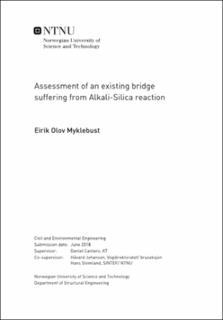| dc.description.abstract | The first parts of the thesis contain a general literature review about damage mechanisms in concrete and how they affect the structural behavior, extended with a more in-depth review of damage due to alkali-silica reactions (ASR). One of the effects of alkali-silica reactions is the formation of a swelling gel, which in contact with water expands. This could lead to severe elongation of a bridge. As the reaction increase on increasing wa ter saturation, some part of the cross-section could achieve more expansion load from the chemical reaction. This could result in curvature changes over a bridge cross- section. In statically undetermined bridges, elongation and curvature changes from alkali- expansion could result in additional moments in which these type of bridges not were designed for. Elgeseter bridge in Trondheim is one of the bridges suffering from this degradation mech anism. Field investigations on the bridge have revealed large vertical cracks occurring at many of the original zero moment sections, 4.5m from the columns at the inner beams. A number of small cracks occurring in the field sections are also reported. These cracks are assumed to appear due to additional moments on the bridge from alkali-silica expan sion, and the assumption that the outer beams are expanding more than the inner beams, straining the inner beams. A limited amount of reinforcement in the original zero moment sections is assumed to be the reason why the most significant cracks appear in these sec tions. As part of the thesis, structural assessment in the longitudinal direction of Elgeseter bridge was conducted, using the original bridge drawings and NS3473 2003, which forms the basis of assessing existing concrete structures. The capacity control of the different sec tions was conducted, not taking into account structural damages or concrete degradation. Shear and moment capacities were on the safe side when neglecting additional loads due to alkali- expansion. When taking additional ASR loads into account, the moment capac ities were exceeded in the field section between axis 1-2 (15%), the internal field sections (27%) and in the original zero moment sections, 4.5m from the columns (92%). A more in-depth study was conducted regarding alkali-silica expansion on Elgeseter bridge, making a 2D model (longitudinal direction) and a 3D model of the bridge in the finite ele ment program DIANA. Adding thermal load was used as the solution strategy to simulate ASR expansion on the bridge models (coefficient of thermal expansion in the reinforce ment was set to zero). Both models revealed large tensile stresses in the original zero moment sections. The crack development on the bridge found by the 2D model seemed to be in good correlation with the field investigations on the bridge. With the 3D model, it was also possible to detect shear stresses appearing on the plate due to different strain over the width of the cross-section at the end span | en_US |

